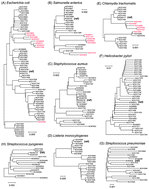Predicting genetic and ecological characteristics of bacterial species by comparing the trajectories of dN/dS and dI/dS in bacterial genomes†
Abstract
Indel (insertion/deletion) causes gene disruption and is considered to be deleterious like non-synonymous mutation during the evolution of bacterial genomes. The trajectory of dN/dS (the ratio of non-synonymous to synonymous mutation) has been found to decrease exponentially over time, but the trajectory of dI/dS (the ratio of indel to synonymous mutation) has not been thoroughly explored yet. Here we compared the patterns of dN/dS and dI/dS for several bacterial species. The majority of them showed a much steeper dI/dS trajectory than the dN/dS trajectory, suggesting that indel was more deleterious than non-synonymous mutation and therefore was more difficult to fix in genomes. However, the naturally competent bacteria, or those with a much lower genetic barrier for DNA exchange, presented a reverse relationship between dI/dS and dN/dS, indicative of an exceptional ability to tolerate horizontal genetic transfer. The result suggests that plotting of dN/dS and dI/dS trajectories can help to predict the genetic and ecological characteristics of bacterial species.


 Please wait while we load your content...
Please wait while we load your content...